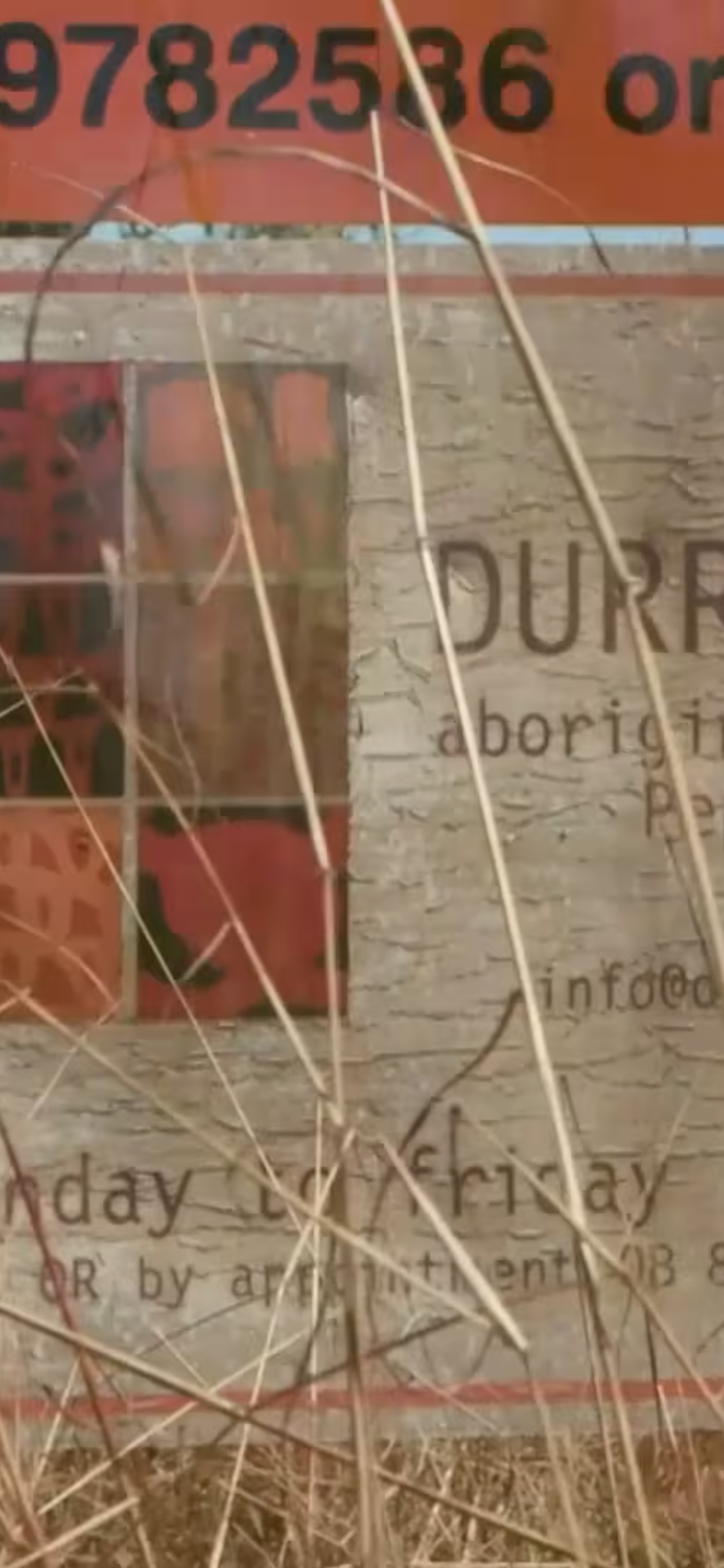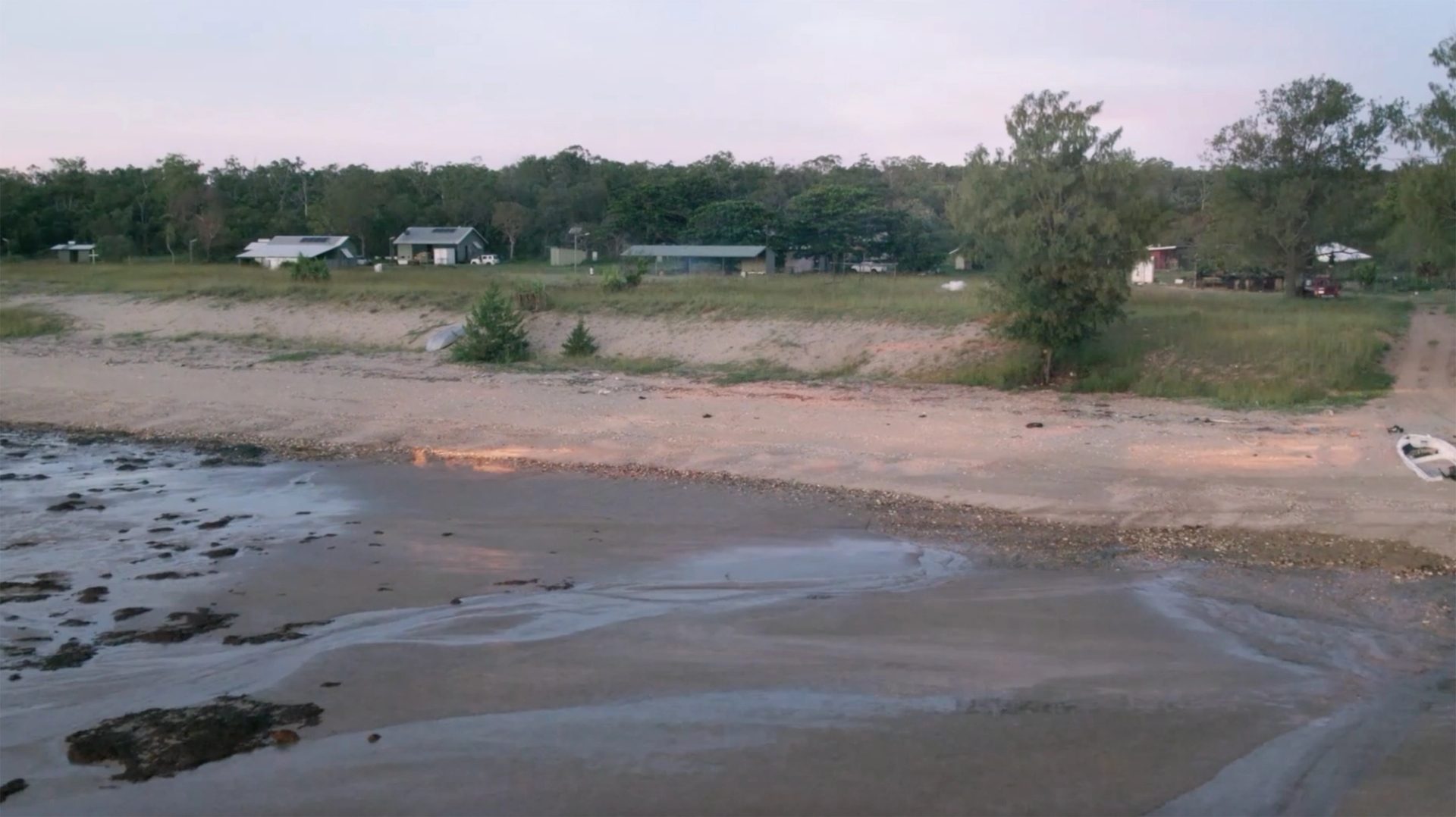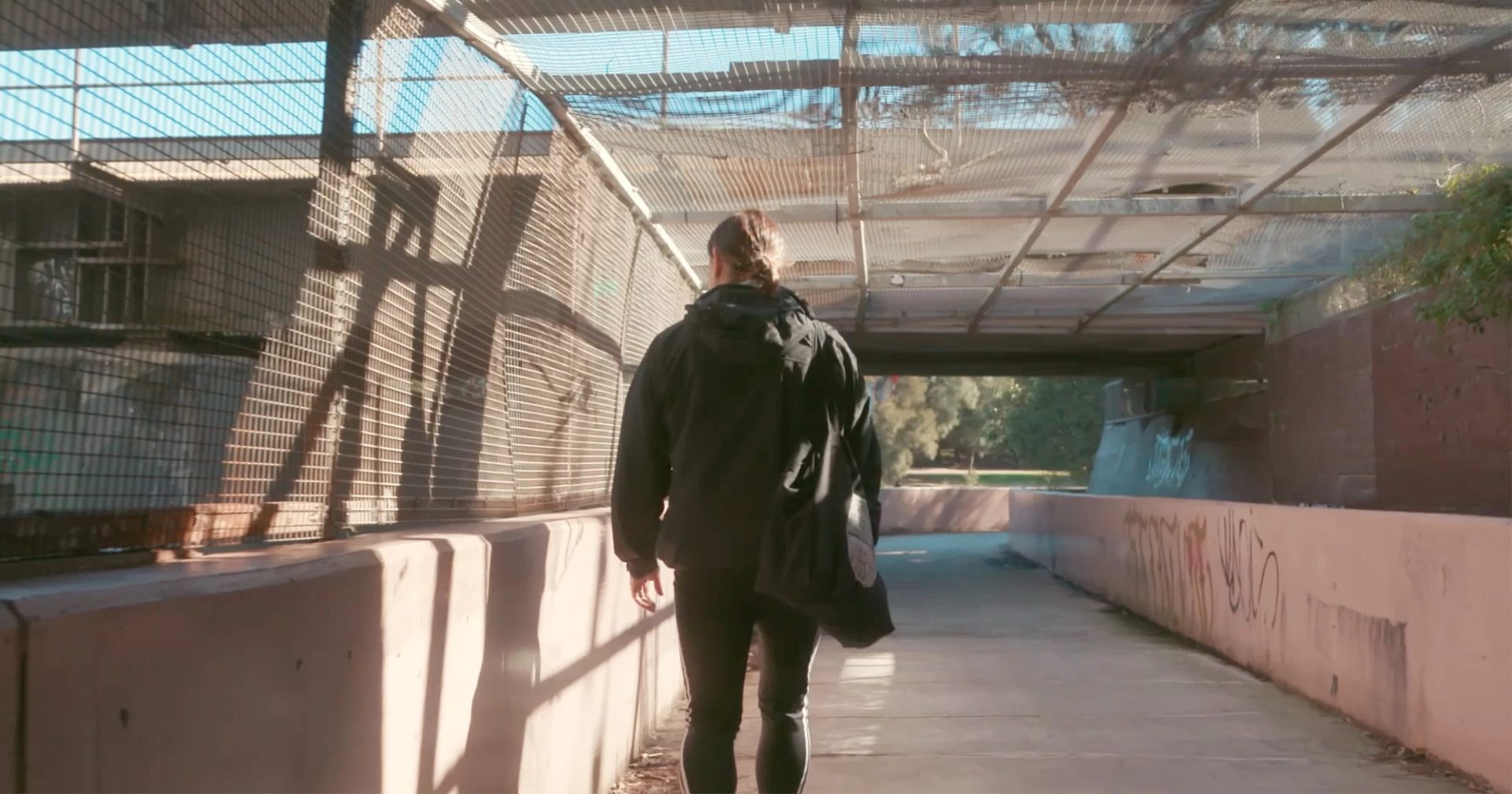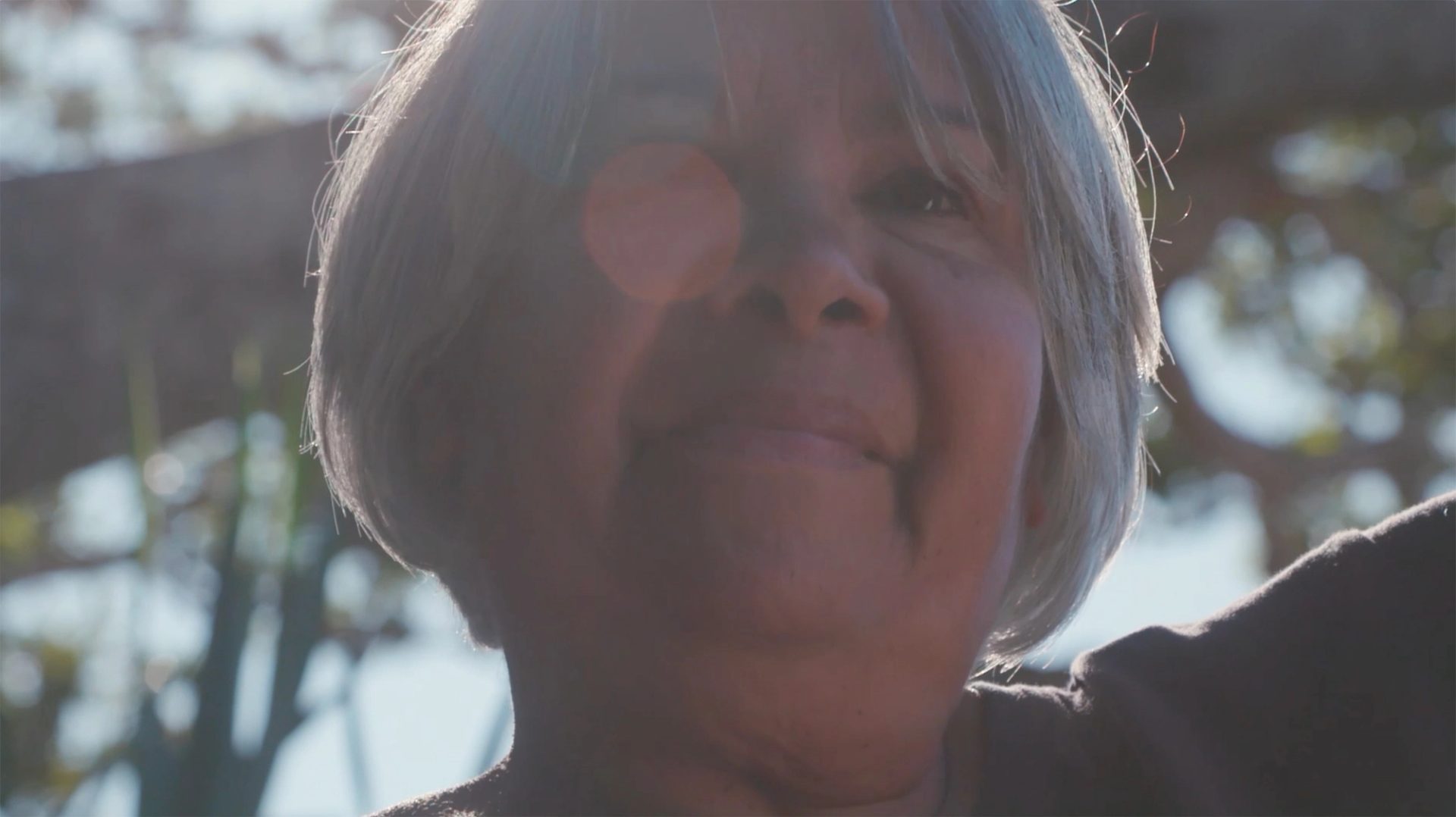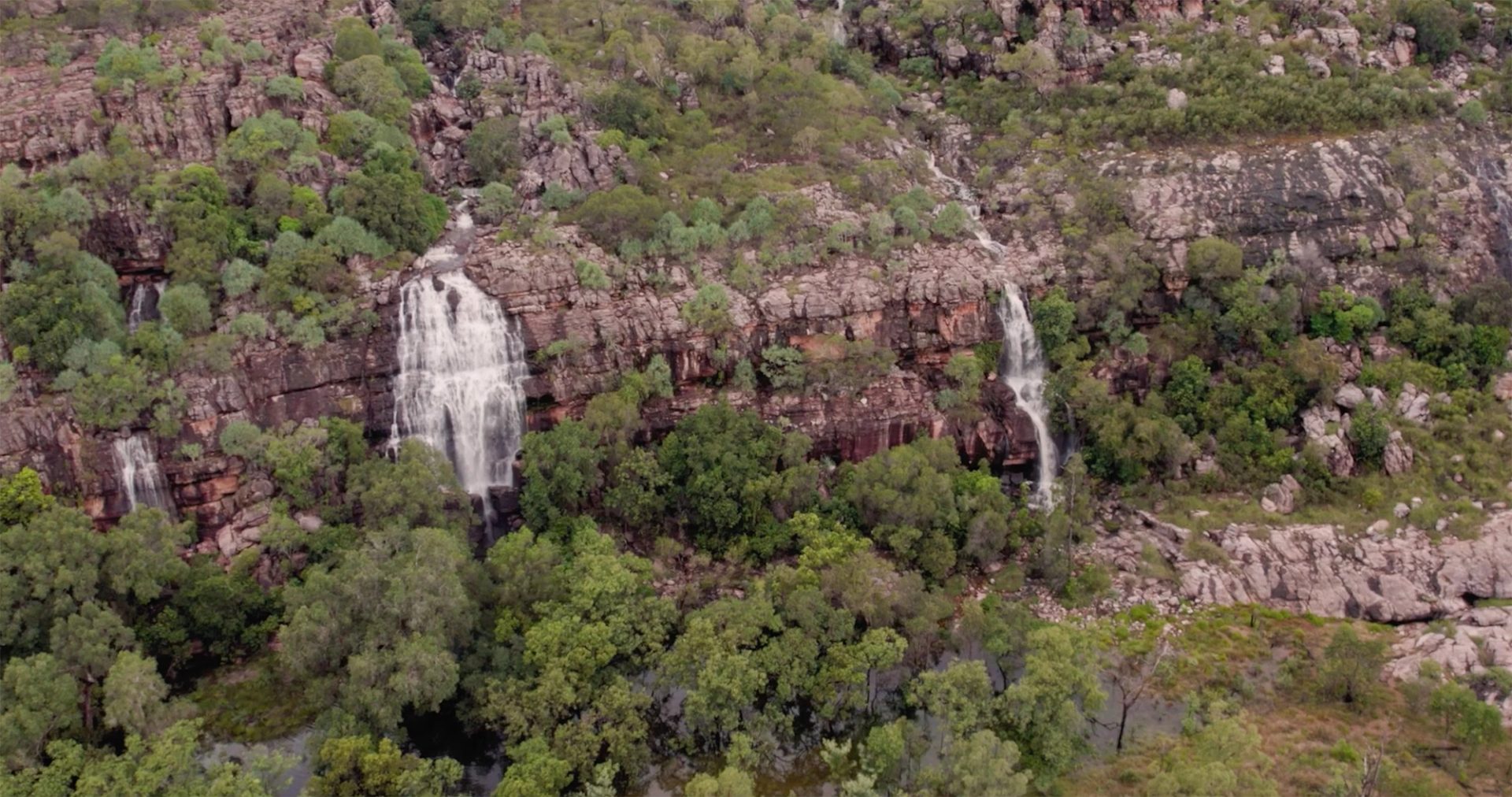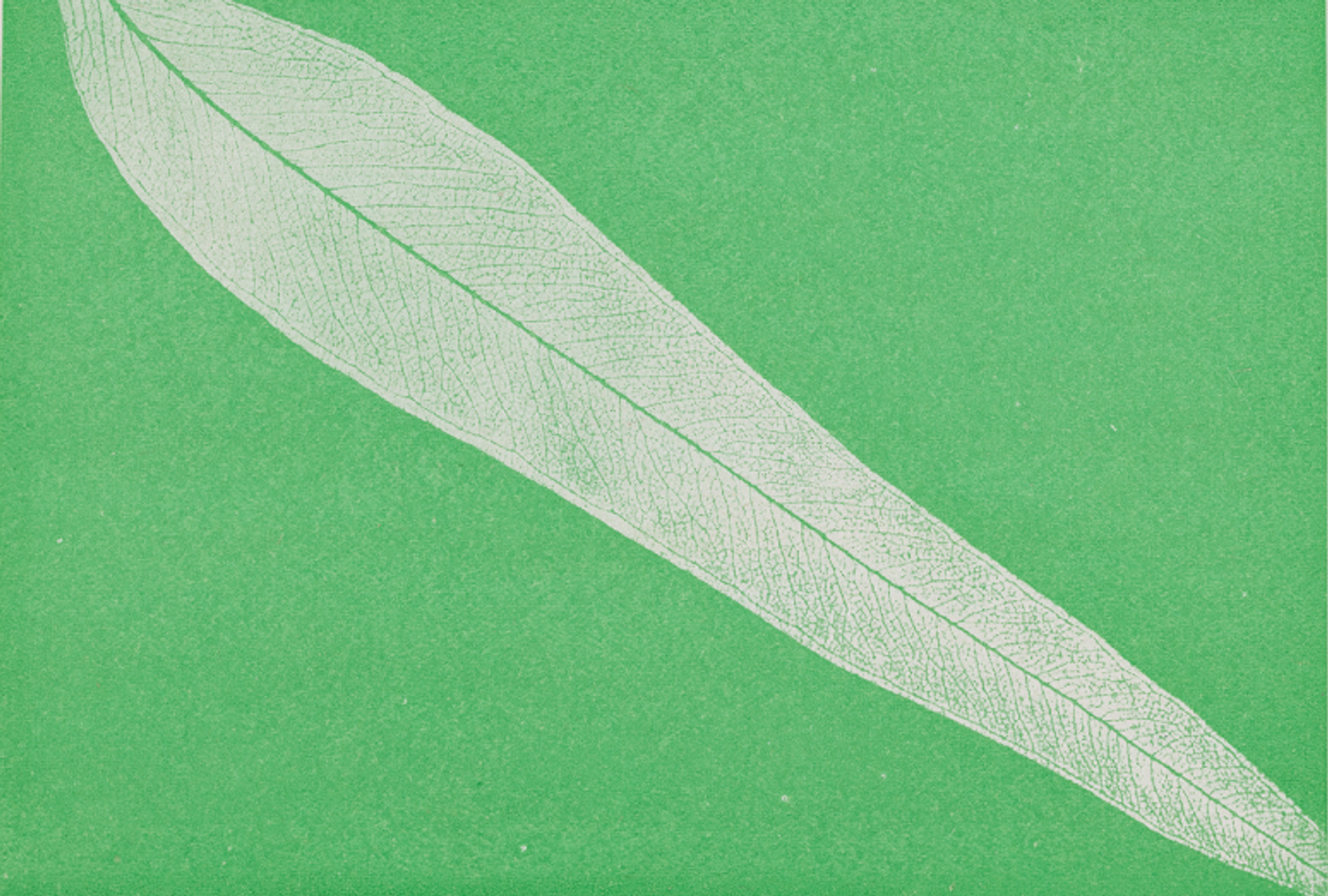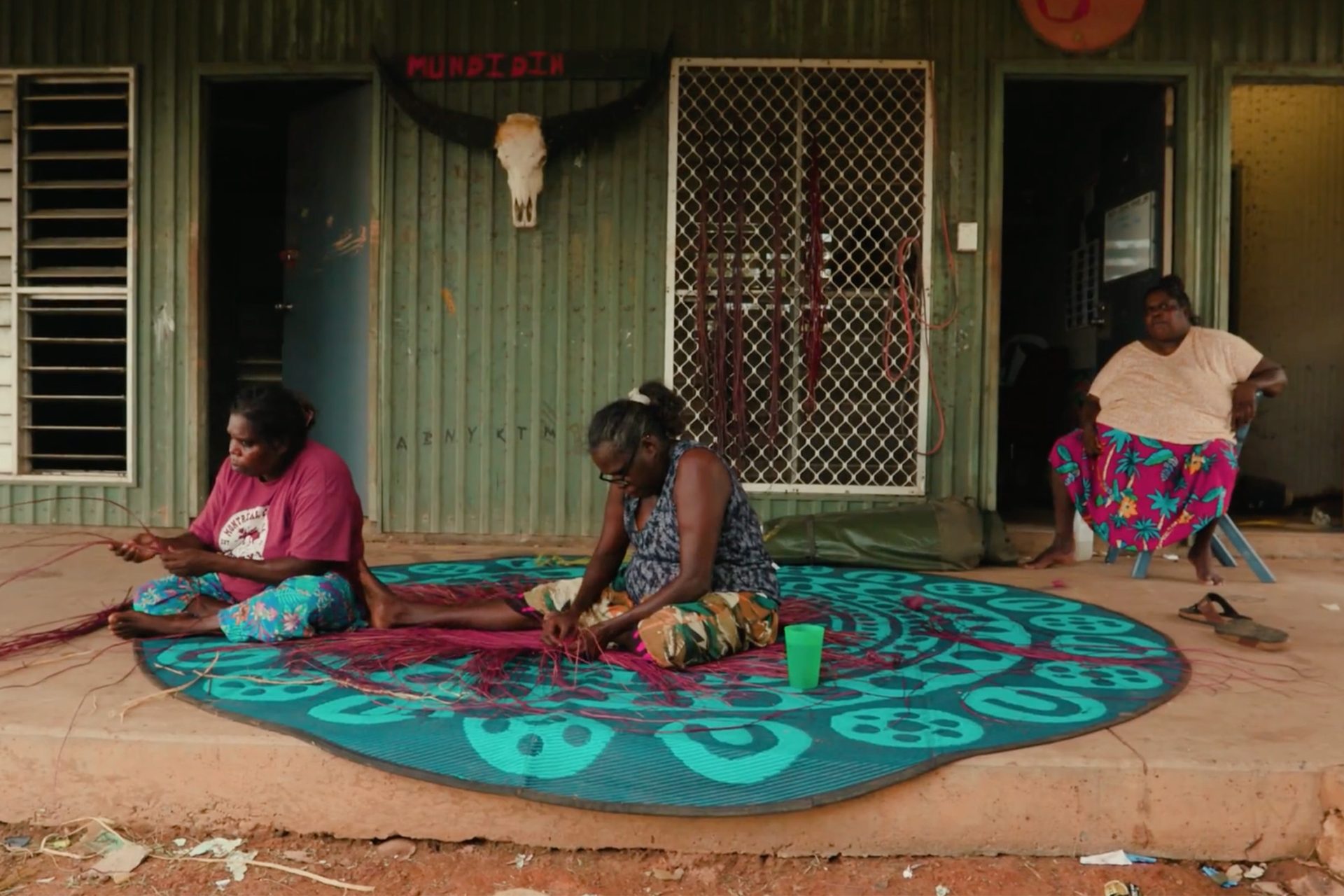Durrmu Arts Aboriginal Corporation

Curator Coby Edgar reflects on time spent in Peppimenarti with Durrmu Arts Aboriginal Corporation artists, as they prepare for Powerhouse Castle Hill exhibition, Alchemy.
‘Regina and a few other women were already weaving on the deck when we arrived in the early morning. Weavers seem to start at the break of dawn and they keep going late into the night sometimes. It's continuous.’
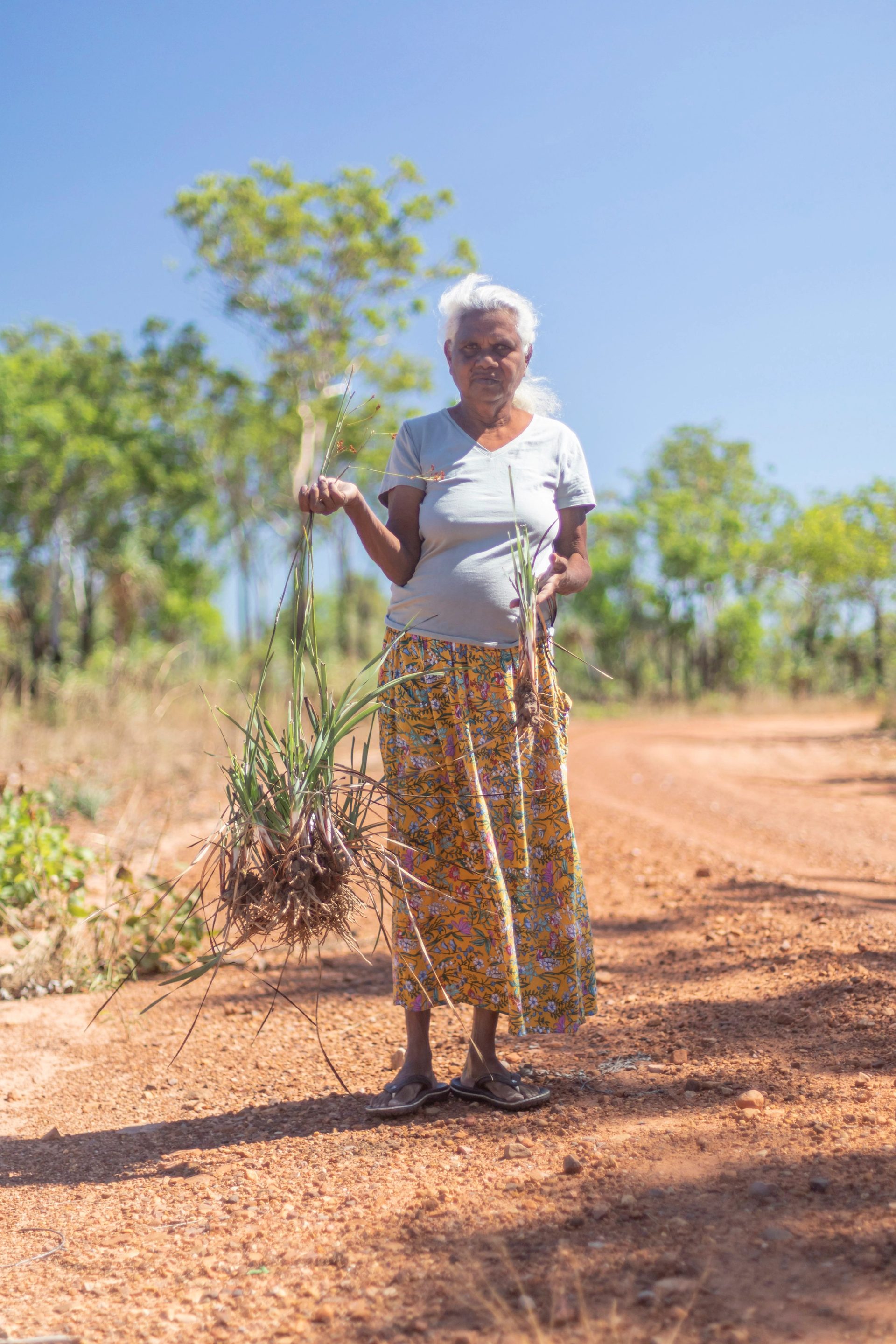
It was August and a last-minute trip was tacked on to an already long few months of travelling. Emily McDaniel, the inaugural Powerhouse Director First Nations, had decided it was time to talk to Agency about the possibility of doing this show, Alchemy. Agency is a not-for-profit organisation that promotes First Nations art, culture and people, and facilitates investment in First Nations-led projects. It was THAT time of the year again. Garma, Darwin Aboriginal Art Fair, Darwin Festival, the Telstra Aboriginal and Torres Strait Islander Art Awards, National Indigenous Music Awards and National Indigenous Fashion Awards. I had missed Garma because I had caught COVID-19. Stuck in my tiny Sydney apartment, I waited for it to pass then headed to Darwin. Straight after these events, Emily had organised for the two of us to jump in a car with Agency CEO Kade McDonald and art projects manager Miriam La Rosa. We would head out to Peppimenarti to meet with Regina Pilawuk Wilson and talk natural dyes.
This is where Alchemy was born for me, on my Country – Larrakia Country – where all these events are held. Emily had preliminary conversations with the art centre managers in town for the event season, scoping everyone’s year ahead. There was certainly interest. After COVID-19 had hit, the number of art commissions had dwindled. Many of the postponed shows were now taking their time in the spotlight. Plenty of artists needing work.
Driving out to Peppimenarti, in the Daly River region, Kade told us about his time working there with Durrmu Arts for a number of years. He is a runner, Kade, taking early morning runs out on this Country as it gets too hot during the day. He told us stories of his runs – he often saw wild horses. I visualised Kade on his morning run, the fog lifting slowly from the ground as the sun warmed the frost away. Sunshine peeping through the long grass in warm yellow lines, the sound of his sneakers hitting the sandy roads in a meditative rhythm.
The drive from Darwin didn’t take too long, around six hours with all the stops. It went quickly. We turned off the main road and headed around winding roads and small round hills until we hit pastoral lands. Suddenly it was barren, flat, dusty and dry. Kade told me about the history of ownership of that particular piece of Country. Dusk was approaching, it’s the worst time to be driving on the roads. Harder to see roos, buffalo, bulls and cows. Sure enough, in true Territory style, a big buffalo wandered into the middle of the road. The buffalo started to charge the car. Kade swung the car into reverse to give it some space and then slowly started to drive towards it. It ran at us again and Kade backed off again and moved onto the other side of the road. The big buff decided it didn’t want a fight tonight and sprinted into the bush. Kade shifted the car into drive and we were off again. As we approached the narrow bridge to cross the river just out of Peppi, Kade sparked up the little NT kid in me. ‘Want me to pull over and we can look over the bridge at the crocs? Got a torch Cobez?’ Of course I did! I sprinted out of the car to the edge of the bridge, barefoot already.
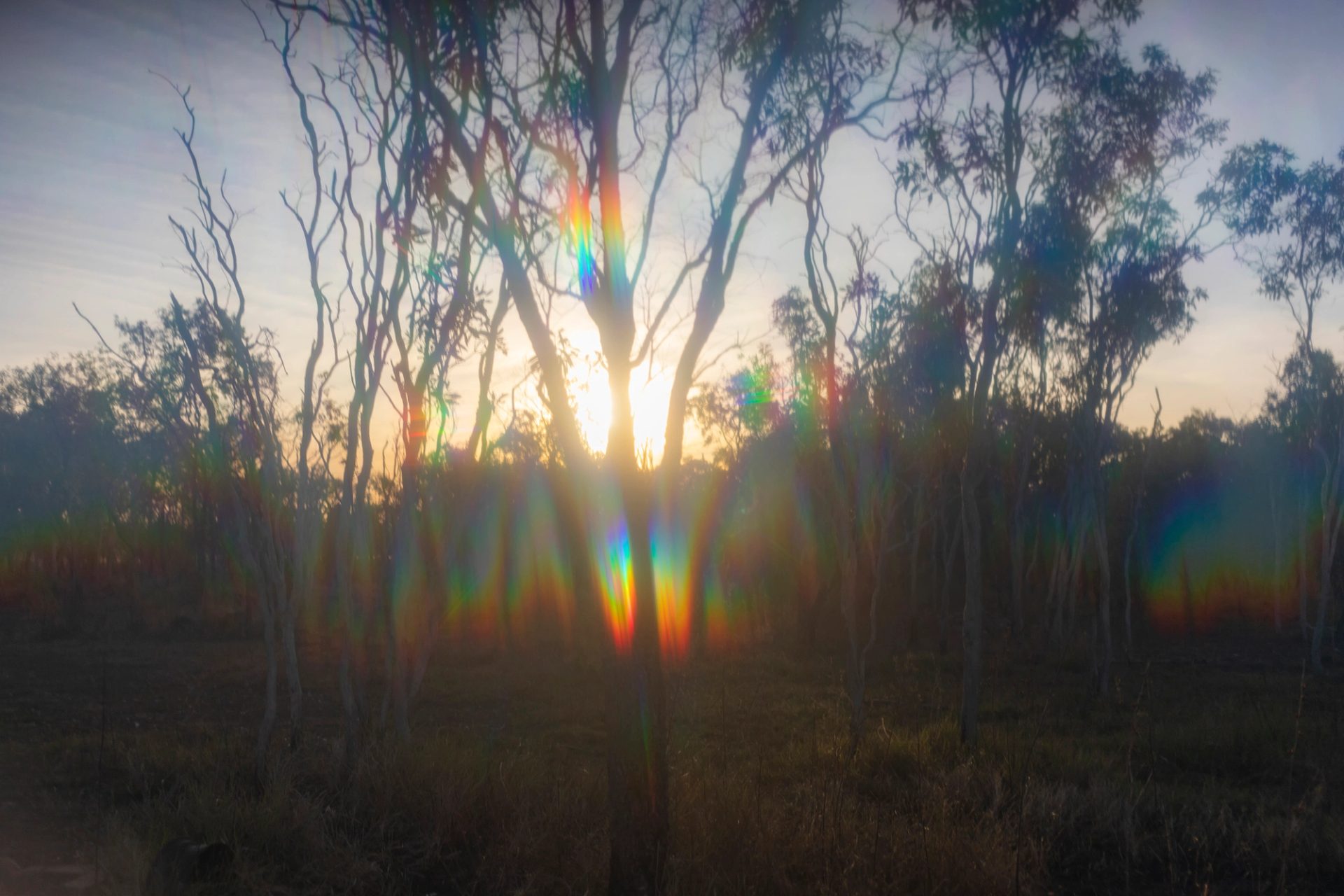
I shone the light over the surface of the water, near the base of the bridge first, then downriver. Little reflective orange and red eyes all over the place. A few big crocs moved towards the light, their tails swayed, rippling the water as they propelled themselves along the surface. I find them hypnotic. You would be in trouble if you fell in.
As we pulled into the community Kade went back into tour guide mode, explaining which bits of infrastructure came first. He pointed out all the relevant buildings and suggested we talk to Regina for the full story. Driving through the town, the homes are all spread out. The community is big. Each loop road holds a particular family group, with their homes spaced well apart. The main street has all the main attractions, the shop, the school, club, the art centre and picnic areas. The lawns are green, the grass is short, there are public toilets in the park area and small BBQ areas for people to use. There are lots of recycling stops, no rubbish around at all. It is a well thought out and cared for community. I asked Regina about her community the next morning. The amount of infrastructure this community has managed to build and run in just over 40 years is truly something to be celebrated. What the people of Peppi have achieved is amazing. There is even a space a little outside the main township where they have built semi-permanent structures for visitors to camp in, with a safe waterhole on the edge of the camp.
Emily and I had a whole house to ourselves. This is a luxury. I am used to sleeping in the art centre manager’s spare room. Peppi is well equipped for visitors like us. Kade, Miriam and Kara Rodski, the Durrmu Arts manager, were in Kara’s house. We all settled into the evening together. I took up cooking duties. As the eldest girl in my immediate family, it’s a knee jerk reaction for me to take hold of the cooking. I am also fussy about my food so I might as well cook. Bit of my control freak starts to show but my colleagues were happy to be cooked for, so it was a win-win. Tomorrow we would meet early at the art centre building to start our day. After dinner Kara, Kade and Miriam headed off, not without us spotting the cloud of massive mosquitoes around them. Kara got flogged a bit and I showed her how to use tea bags to soothe the bites. Out came the repellent.
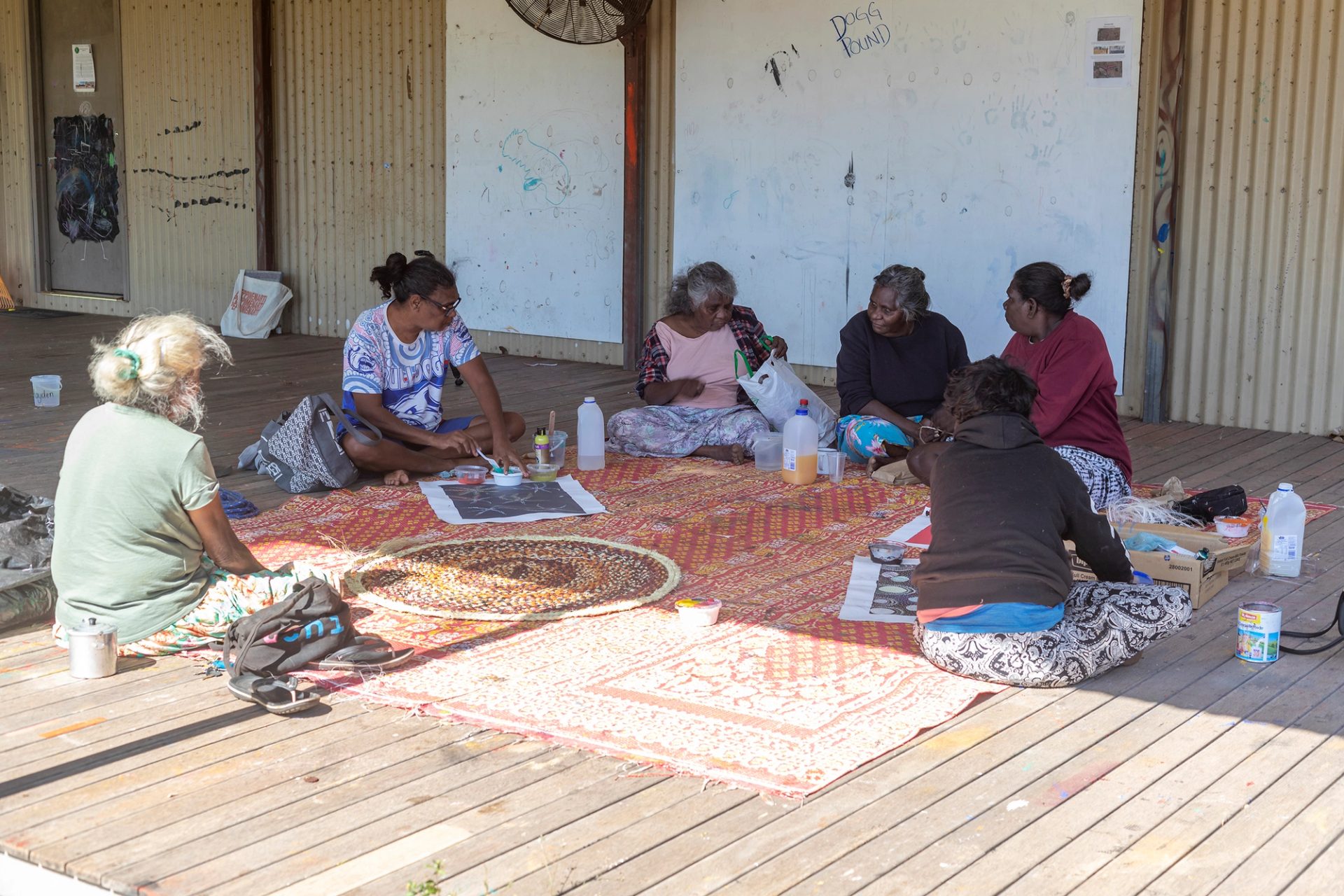
Regina and a few other women were already weaving on the deck when we arrived in the early morning. Weavers seem to start at the break of dawn and they keep going late into the night sometimes. It's continuous. The women carry around bags full of freshly dyed materials and add to the pieces they are making around the clock. They take the kids to school, sit and weave for hours. Make dinner, sit and weave for hours. That morning they sat beside large bags full of dyed pandanus and bush string, and the pieces they were working on sat partly finished in front of them. I walked over to the shop for a morning snack. A sign on the door said, ‘no school, no shop’. I bought a carton of Paul’s Iced Coffee. Sugar and milk with a little bit of coffee. It’s a Territory favourite and is probably responsible for a few of the fat rolls around Territory middles.
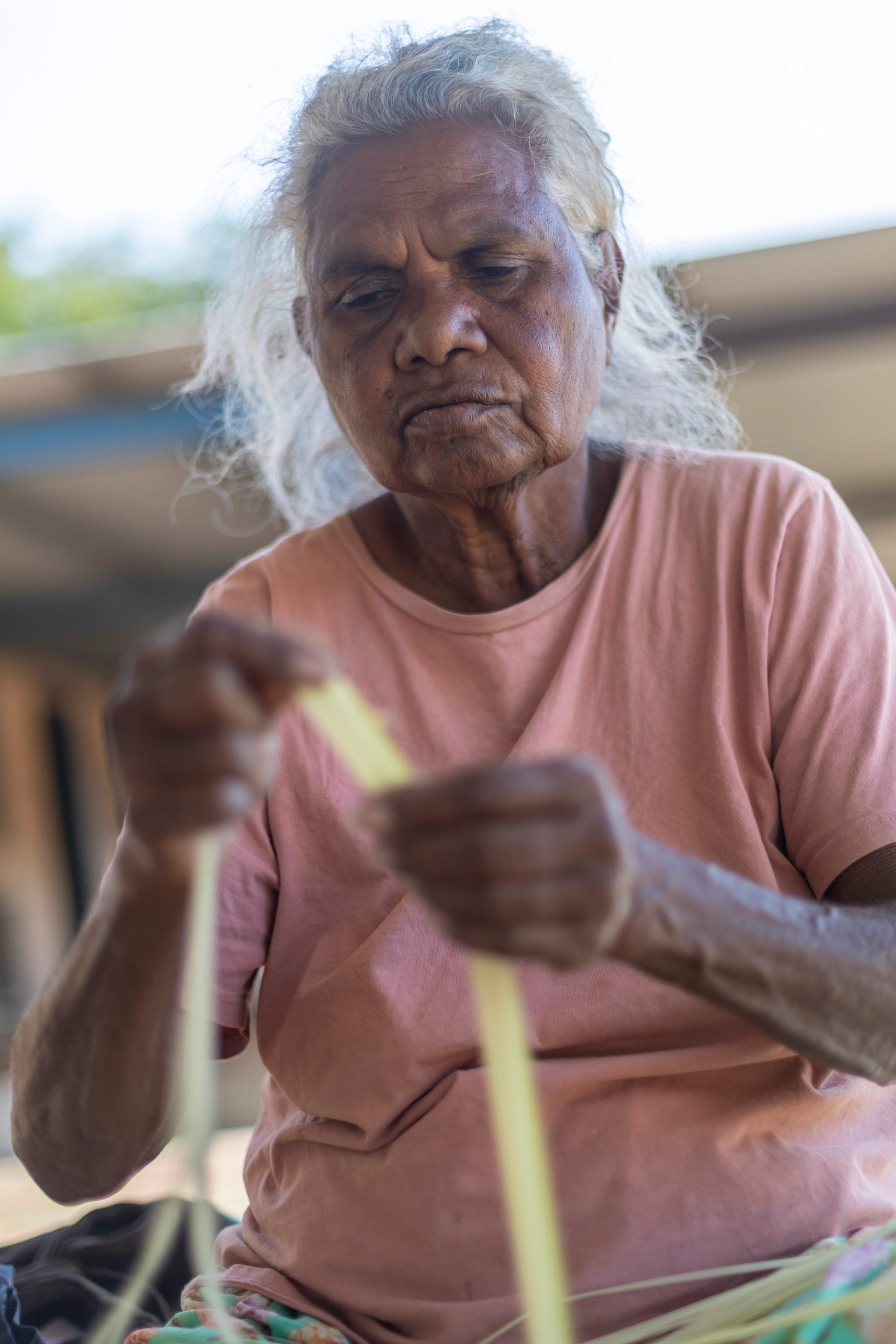
The exhibition’s videographer Tim Hillier had been in Peppi a couple of weeks before us, with his brand-new baby girl and partner. He has a close connection with Regina and did some filming for Alchemy on his visit. Perhaps his little baby Luna will become a part of the extended arts family, she will probably come back here again someday.
Regina and her daughter Annunciata Nunuk Wilson were looking after us on this trip. The story of their community is one that should be told as part of a school curriculum. The community of Peppimenarti is located about 300 km south-west of Darwin. In the early 70s Regina’s husband Harold Wilson walked off the mission at Daly River and set up the settlement of Peppimenarti, on the Country where he was born.
Harold was a prominent member of Unia, an independent Aboriginal organisation that campaigned for establishment of a cattle station within the Daly River Aboriginal Reserve, resulting in 2000 square kilometres of pastoral lease being granted and later consolidated by the Land Rights Act in 1976. Harold later became the president of the Peppimenarti Association and established the permanent settlement. A testament to him, written by his friend Slim Dusty, hangs in the community club. Slim also wrote a song called ‘Plains of Peppimenarti’.
Since the passing of Harold 25 years ago Regina has taken on an unfathomable amount of the responsibilities in this community. She has the only gun licence (needed with so many natural predators surrounding her community), liquor license and is the Elder of this community. If you want to drink in this community, there are limits. They only have mid-strength beer. You can only have three a night. You need to have a non-drinking chaperone with a valid driver’s licence and there is a free BBQ. The club is only open four nights a week and Regina’s daughter Nunuk runs the night patrol – taking people home or sending them home if they misbehave. People from the neighbouring dry community of Wadeye often come here. Regina often completely closes the club. A non-drinker herself, she understands people have the right to a drink occasionally and embeds rules to make it as safe for her community as she can. Often, that means a complete ban. The power of this woman should never be underestimated.
There is trouble in the community on and off, like most. Wadeye is in a constant state of unrest. It is the community where my father was shot at in his early career as a cop, and the isolation puts police officers at high risk there to this day. The bullet missed his head by millimetres, he felt the heat of the bullet pass him. Peppimenarti has been grappling with incidents of violence in recent years. These communities need government support to deal with this and have been asking for it for years. The situation is past dire, yet their artists are some of the best in the Country. Regina will go from standing on grand stages as a community leader, artist of excellence and Australian diplomatic representative overseas but when she returns to her community, Australia turns its back on her. There is no rest for Regina and her family and yet she still rises, advocates, teaches. You can read about violence in Peppimenarti in the news but you won’t see it in the many papers written about Regina’s work in the art world. That seems too hard to look at, her art is what they are interested in. Nunuk can be found quoted in news articles. Read her words, the people of Peppi are in the literal firing lines. They have invited the federal police and army into their community to talk about ways to help a community in crisis and resolve the social issues. To no avail. Racism is alive and well. It is pure madness.
My employers would probably have had hesitations about me travelling there if they understood the intricacies of the situation. I know my Country and my people though, and I know when I am safe and not. I know well enough that if Regina deems it safe then I will be safe. I went out there, like I did every other community. The NT Police Minister didn’t. Her private plane was diverted because of civil unrest threats. I was not able to return to Peppi after this trip as unrest came back to the community. I didn’t for one moment feel unsafe while I was there. Not even for a blink. I am a visitor. It is not me that the aggressors have business with. Two rules one Country.
Regina was part of the very first conversations about this project before anyone else had been approached. That was on purpose, she is the right person to consult with. We wanted to look at the botanical and scientific knowledge of Country that the people hold. The knowledge that comes out in beautiful colours of Country in naturally dyed fibres. She is THE master of this. All for it.
Regina knew straight away what we were asking for when we arrived in Peppimenarti. She jumped into a troopie with her daughter Nunuk at the wheel and we followed. Out to Country to dig up dye materials. Nunuk drove quickly down their familiar roads then came to a hard halt. Two blades of grass about 20 cm high were what she had spotted. Jumping out with a crowbar, she dug deep. Showed me the plant, the different uses for each part of it. Most importantly, she told me off when I walked off with the root and showed me how to put the plant back into the ground, so that more can grow. This was not her first time showing people her Country like this. It was sweaty hard work in this season. Nunuk remarked at the hot weather and we went back to the art centre to dye and process the small amounts we had gathered.
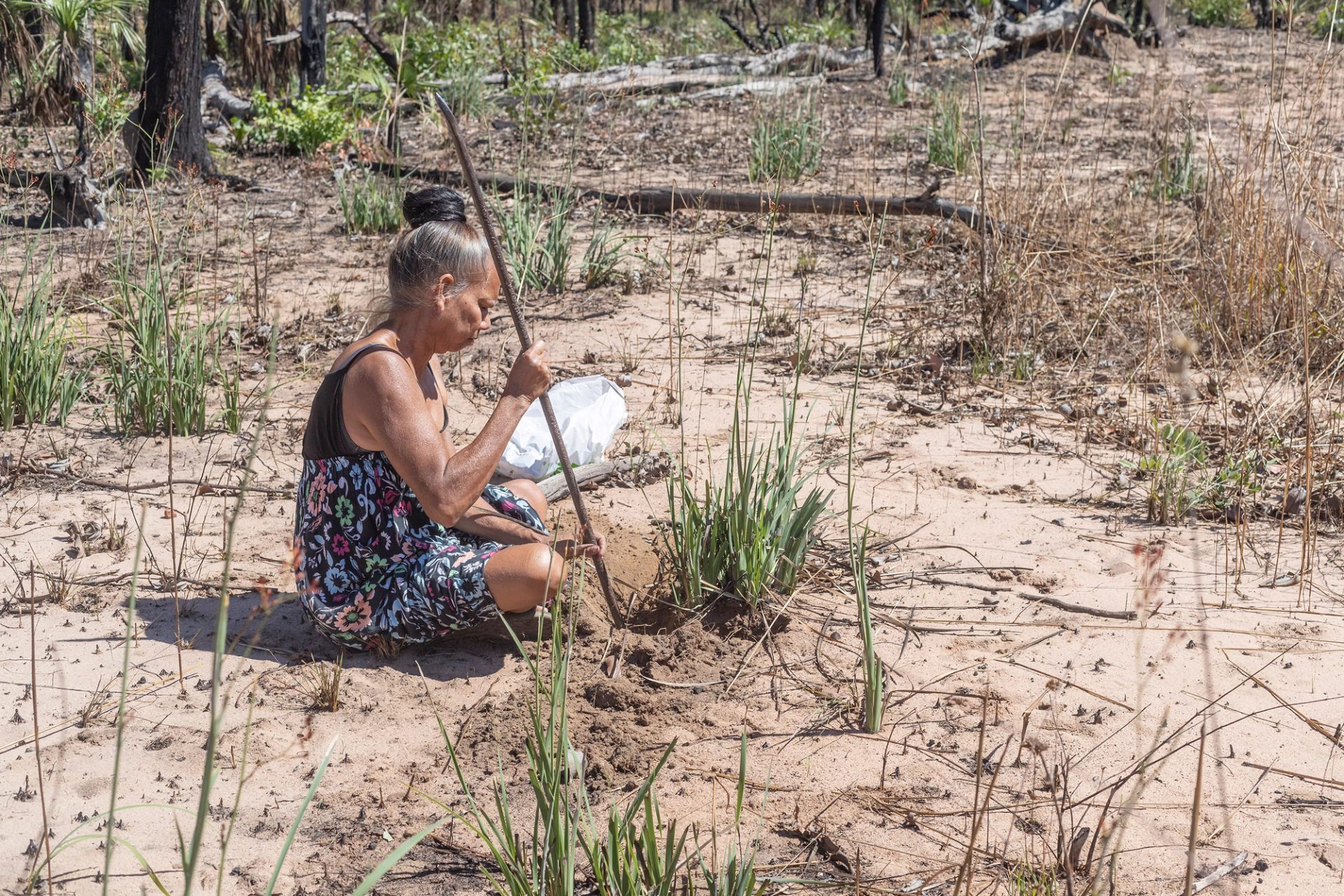
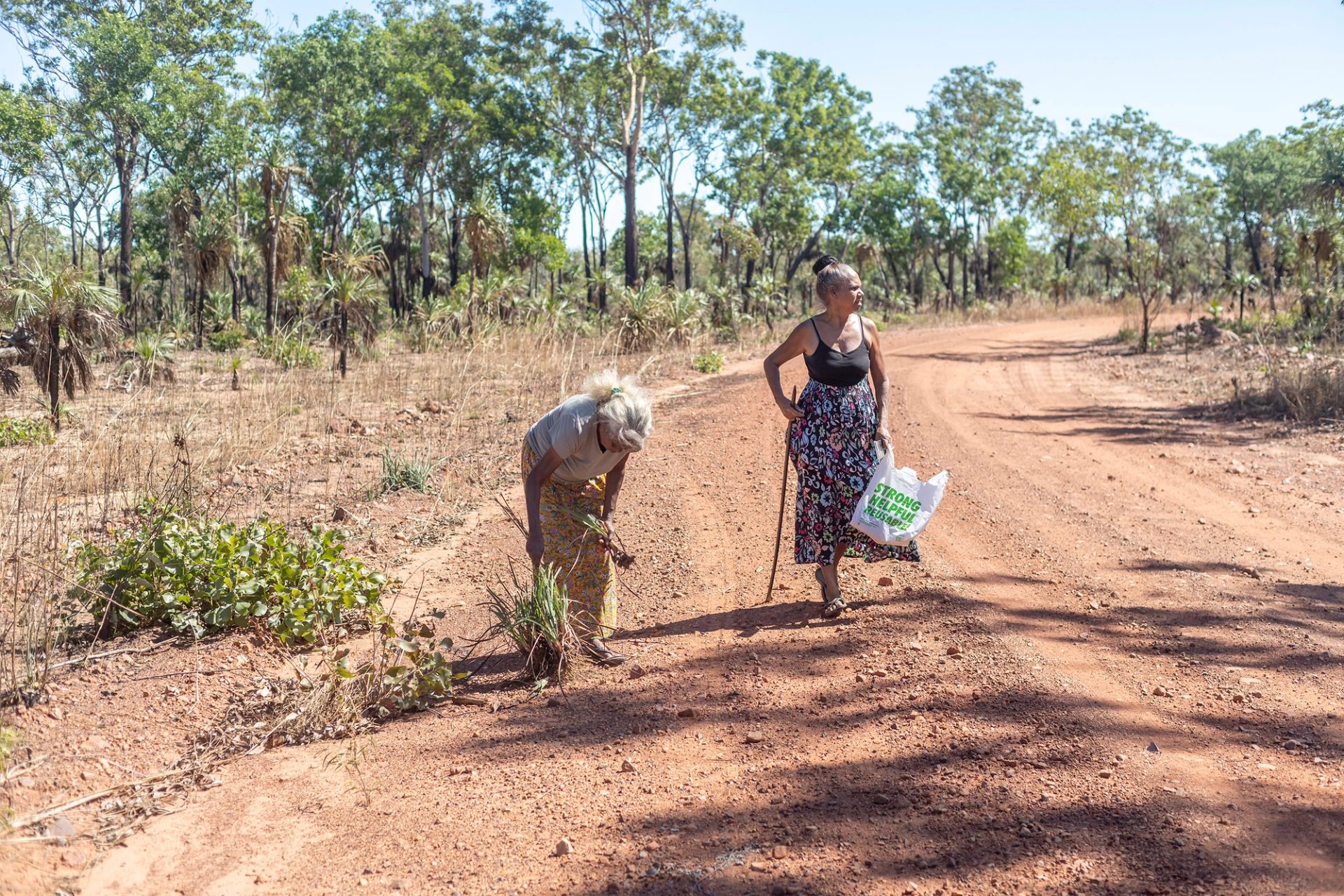
The root we harvested makes a yellow dye. The outer layer is scraped away and then the root is crushed up. I love that in every community the way of crushing is a bit different. Old bricks are used a fair bit, something heavy and with a straight edge. Many of the materials and tools used are recycled. The women don't use tongs, they just use a bit of cardboard.
They don't go out and buy vats to dye in, they use old Chupa Chups containers, 20 kg washing powder containers, they use what's around. The Chupa Chups container is burnt on the bottom, its vibrant candy colours contrast with the natural fibre colours. Two worlds colliding.
During our dyeing session Nunuk showed us how to make four colours used in their work. The yellow is like turmeric, bright and vibrant. The purple is a small berry, so vivid in colour that a single berry can stain your fingers. Pinched between the fingers the berry pops and the film of the skin is slimy and sticky. Dried up, it is almost the same consistency as charcoal, it crumbles and cracks. The red is a mixture of the yellow and some ash. Just a pinch of ash from a particular tree can do the job. I watched Nunuk mix it up in an old Coke bottle with the top chopped off.
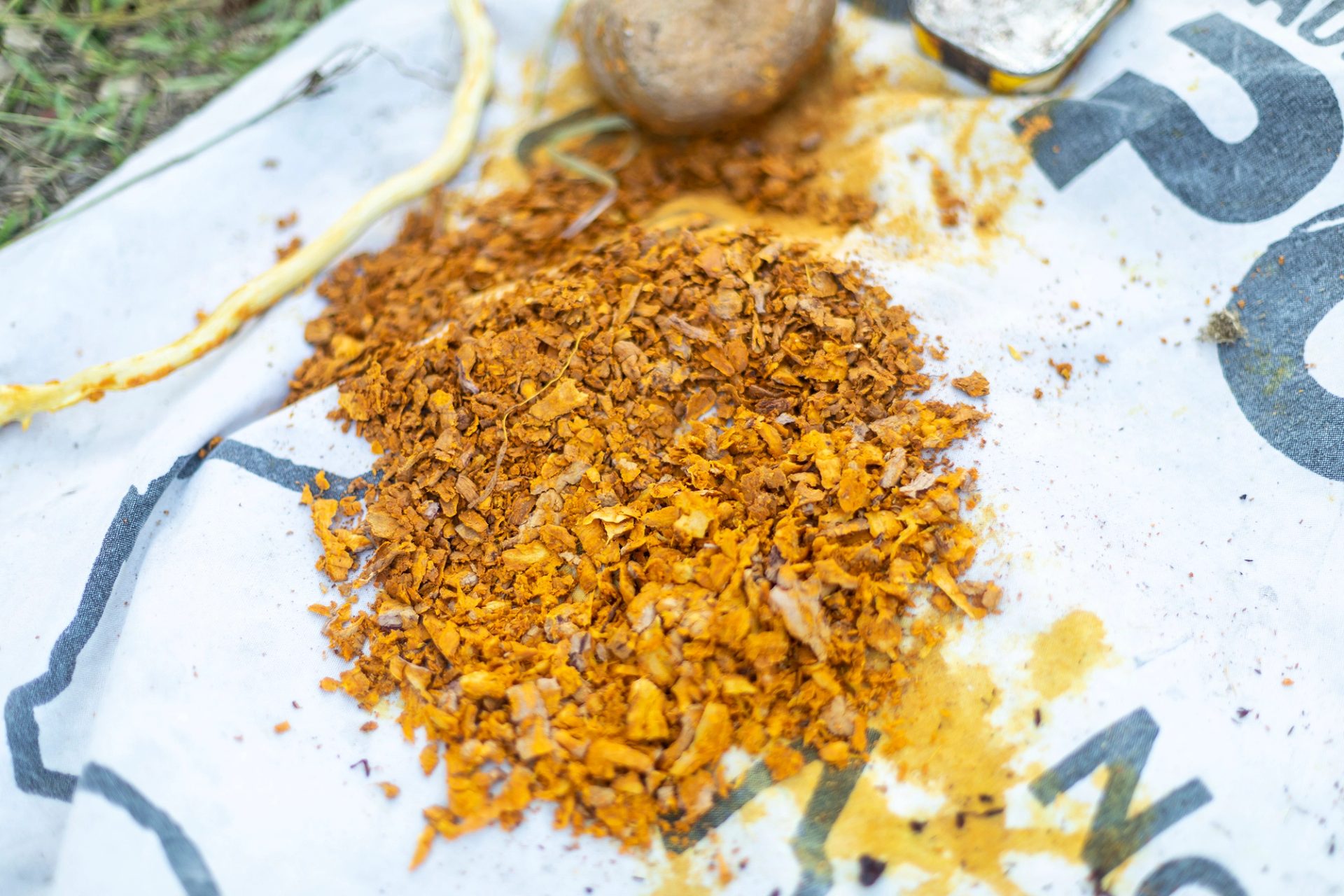
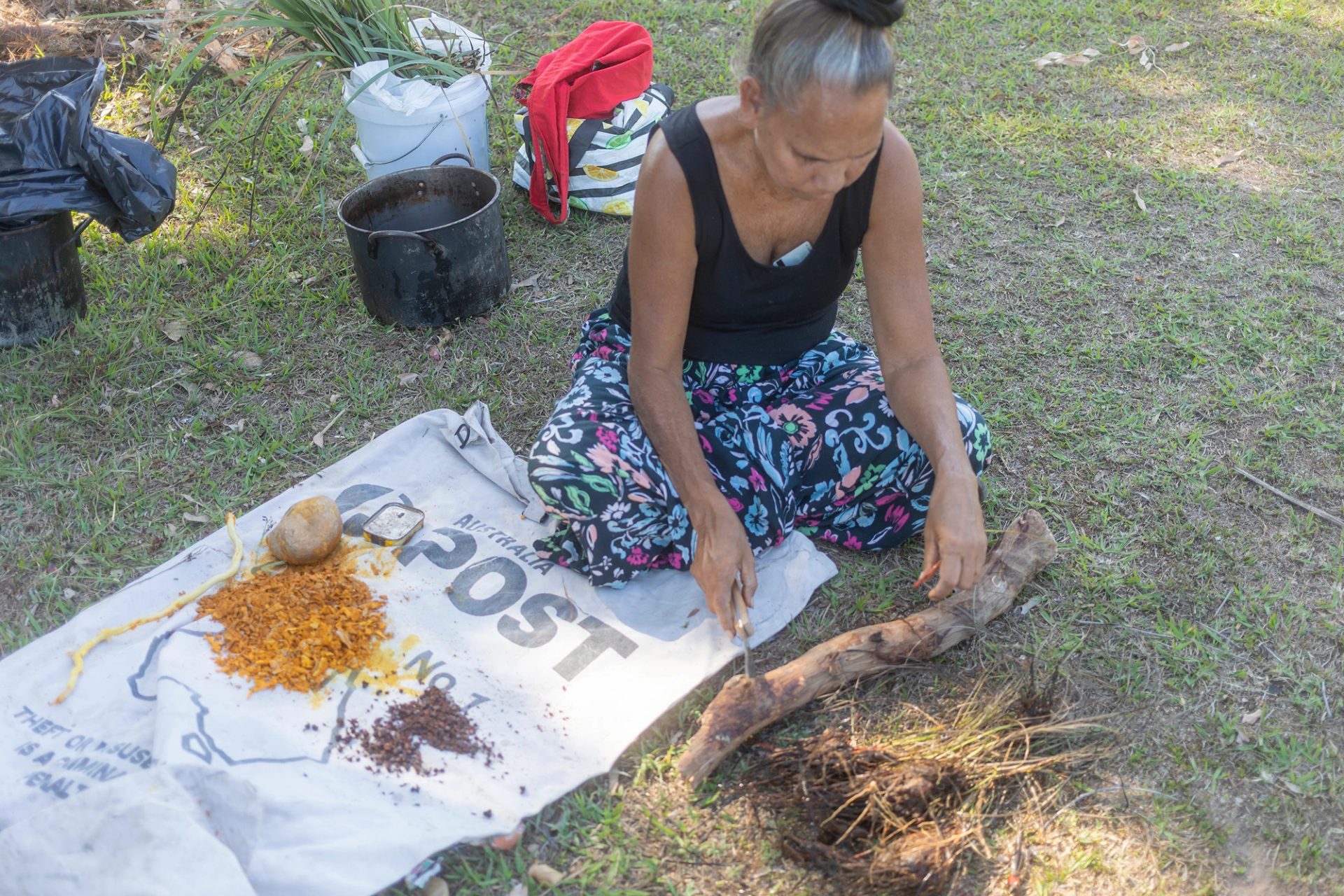

It has taken the whole community to work together to get materials ready. The men went out and gathered large amounts of wood and chopped them up into manageable sizes. Not a single woman or child was left out of the processing. They appeared from all over just in time to chop, scrape, pound the materials together. After a few days of intense dyeing and processing the plant materials, the women started on their objects. Some of the women were finishing off bush string bags, using a piece of cardboard to keep the shape nice and square. Others were making mats, the long fibres are softer to the touch and the thickness of the texture gives it a squishy feeling to sit on, it's thick and comfortable even for my bony backside!
While the women are weaving in the shade they often have some competition for the good spots out of the midday sun. Migo the cow walked into the community as a baby and was adopted by the locals but he’s now a big animal. He likes to sit next to the women but is shooed away when he is getting in the way, just like a dog. Not a dog I would want to wrestle with. I will admit that I looked around to see if there was a tree or a building I could easily scale if Migo decided he didn't like me. Regina had a good laugh at me hesitantly approaching him to give him a pat but to my absolute delight this damn cow rolled over as if to say, ‘Can you scratch my belly?’ Nunuk told me that Migo is also a security guard – if people are being loud and carrying on, he chases them. Migo the peacekeeping cow. I looked to Regina to see if Nunuk was pulling my leg but no, she raised her eyebrow and smiled as if to say, ‘She isn't lying, Migo is our cow-dog’.
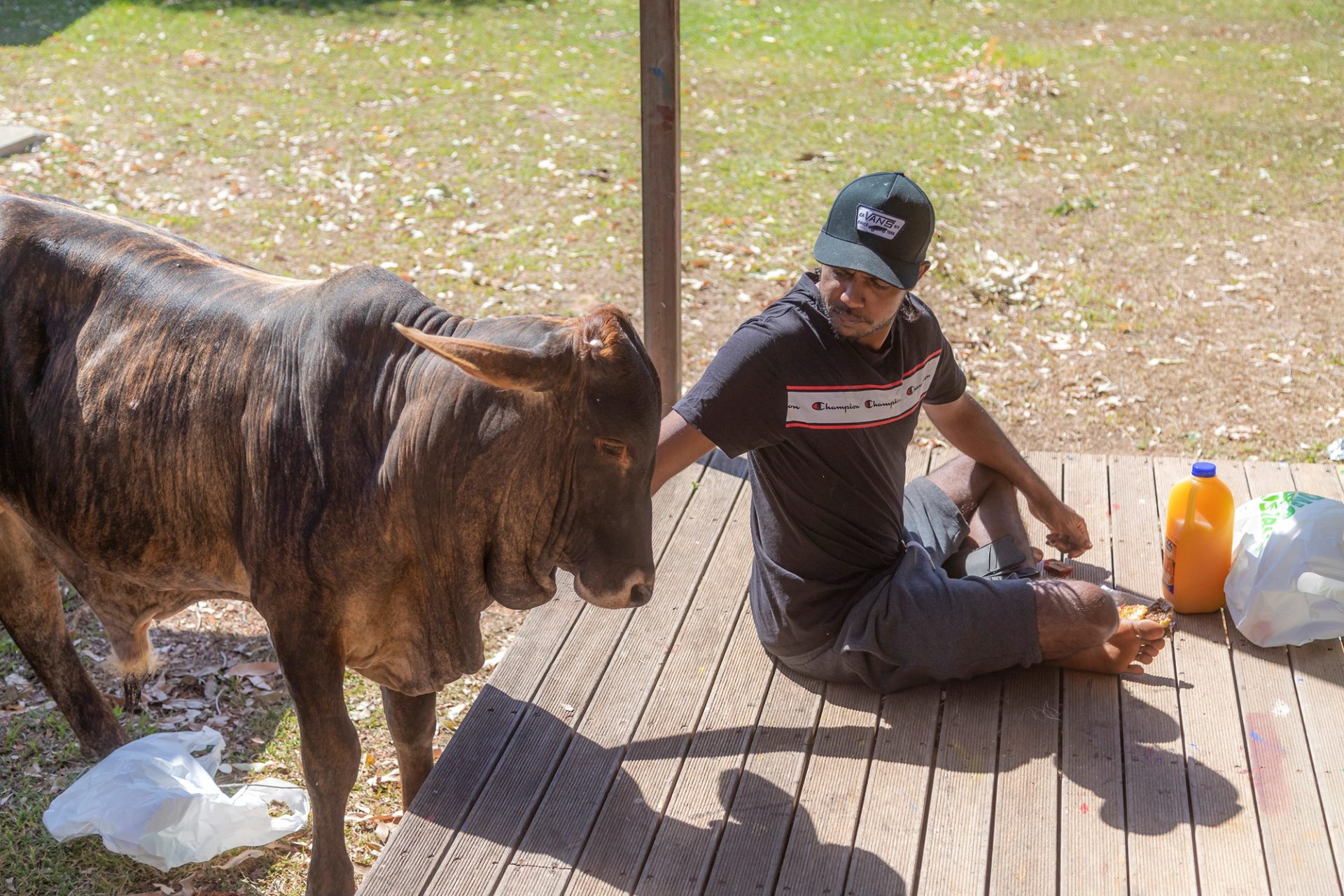
Regina took us into the old print room and up high on the wall was the first painting that she did back in the 1990s. It has the same tones she uses now and you can see how she adapted her weaving techniques to reproduce her designs and patterns in paint. It was amazing to look at the work from 30 years ago and see how her painting practice has evolved. She now works at such a large scale and I can see the amount of detail she includes has also increased. In recent years Regina has had some of her paintings of mats printed onto fabrics and had dresses made up. The dresses were made with beautiful Italian fabrics during a trip she did over there. I am not really a dress kind of girl but when she offered me a dress to try on there wasn't any way I was going to say no. Eager to see what it felt like on, I went into the art centre office. Half nude and awkwardly trying to fit into the dress, Regina accidentally walked in. We made eye contact and screamed! She closed the door, laughing when I came out in the dress. Good thing she has seen plenty of young women's bodies, I could have died of shame….! The fabric was nice to wear but Regina looks much more elegant than me in her creations. These ones are not for sale, they are for her and her daughters to wear. Special ones. It was time to move on. We left the community with an open-ended conversation. Regina’s response would tell me what to do next.
Months later, Regina had decided what she wanted to do for Alchemy. Walipan, the fish trap. Made with jungle vine for the skeleton and bush string for the exterior. Beautifully dyed and about the process of making, with this work the Peppi women want to show you. The particular weave used is the first one Regina was ever taught. The women do not use it often as it is unforgiving in every sense. The vine grows upstream so you need a boat and some good rains to be able to go and harvest it. You need to know the waterways and where to go, and where the local crocs are so you minimise the risk of an accident. Then once you have the material it is difficult to work with but once in its form it is staying that way forever! This walipan is a new design made from the oldest weave and material that Regina learnt to harness. She made a contemporary design of a form that would feed an entire community of people. A form like this would sit in a stream or a body of water for a few days and be checked periodically for fish and turtles – hopefully not a small croc. These fish traps are built to last and be durable. Once made, the trap is a source of food for many years, although frequent repairs are needed when the wildlife damages the form. They are brilliant designs. Smart woman. She would teach this design to the other women too; this is not one they have done for more than 30 years. Smart woman.
Regina’s concept for the walipan in Alchemy was to leave it partly unfinished, the edges frayed and ready to be spun. The walipan would be displayed as if it was being worked on so that people could see every colour, fibre and strand that went into the work.
Within the exhibition visitors are invited to sit on the five small mats on the ground where the five artists would have sat to add their contributions. There are also cushions for visitors made from printed fabrics created in a collaboration between Regina and Koskela. Some of the pandanus fibres next to the mats wait to be picked up and worked. We can see how each weaver contributes to the larger form. This is how the artists work together and this is how these objects are made, together. It is the only work that is part-finished so people can sit where the artist sat and see what she saw. Powerhouse is all about process and Regina knew that from the get-go, so she let us into the process. Regina Pilawuk Wilson and lead artists Annunciata Nunuk Wilson, Anastasia Naiya Wilson, Doreen Derrity and Delina Wilson have created this walipan, with essential help from other community members.
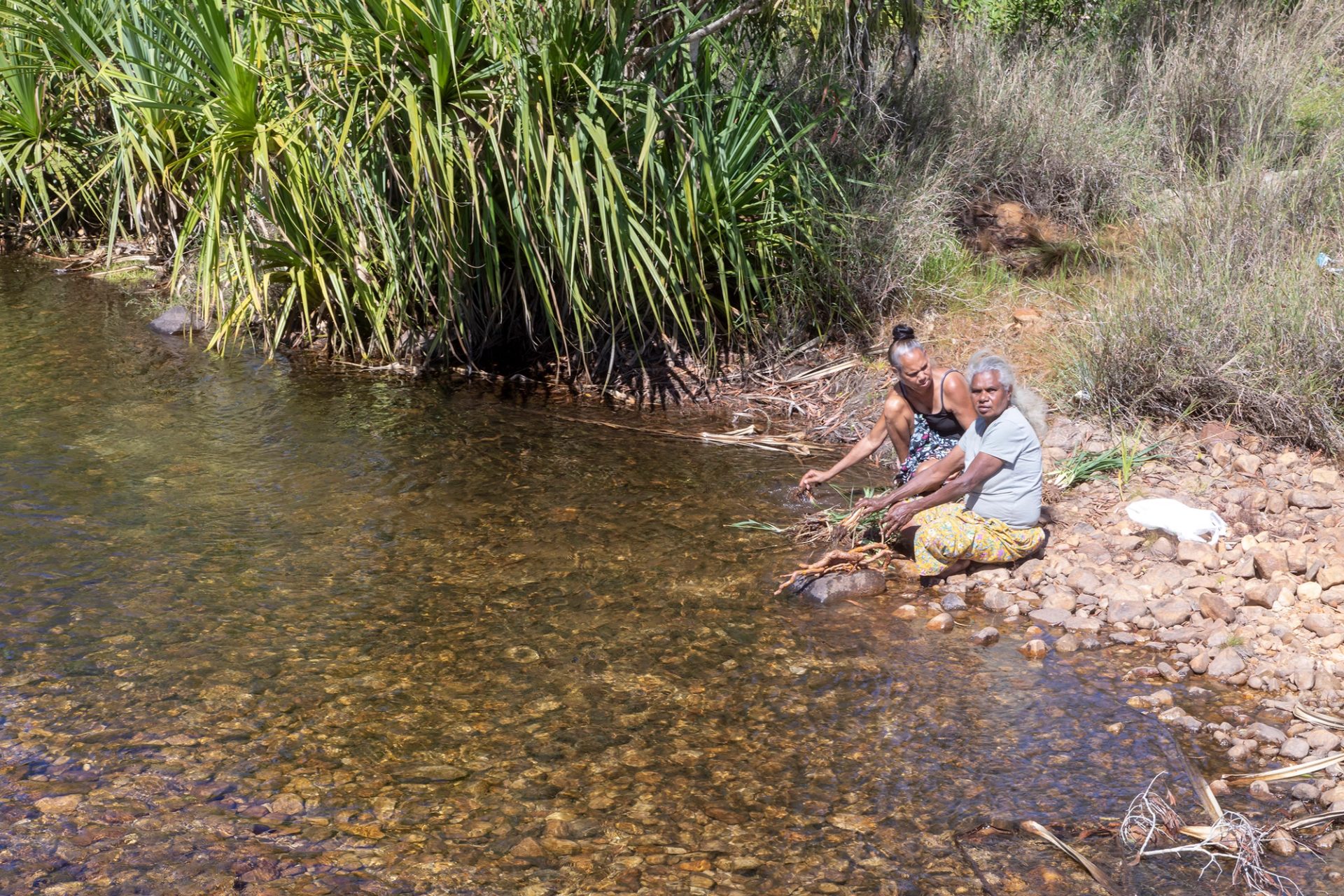
Contributing Artists
Regina Pilawuk Wilson
Ngan’gikurrungurr
Regina Pilawuk Wilson's work is exhibited widely and housed in public and private collections both in Australia and internationally. She is regarded as one of Australia’s leading Indigenous artists and is the founder of the Peppimenarti community – the permanent settlement for the Ngan’gikurrungurr people in the Daly River Region since 1973. The location of Peppimenarti is an important dreaming site for the Ngangikurrungurr language group and informs Regina’s art and weaving practices – skills she inherited from her grandmother and mother. After attending the Contemporary Art Biennale (Pacific Arts Festival) in 2000, Regina decided to add acrylic painting to her repertoire. Regina experimented with various painting techniques and designs during workshops held by the Darwin gallerist Karen Brown. During this time, she started to transfer her weaving designs and patterns into canvas, including syaw (fishnet), wupun (basket), string bags, wall mats and sun mats. Regina won the General Painting category of the Telstra National Indigenous and Torres-Strait Islander Awards in 2003 for a golden syaw (fishnet) painting.
Annunicata Nunuk Wilson
Ngan’gikurunggurr
Annunciata Nunuk Wilsonis the eldest daughter of Regina Pilawuk Wilson, and an emerging artist at Durrmu Arts. Annunciata paints durrmu (body painting dot) designs in the traditional colours of weaving dyes: deep purples, ochres, black and red. More recently, Annunciata has developed her painting practice and has started experimenting with sun mat, basket stitch and merrepen leaf designs.
Anastasia Naiya Wilson
Ngan’gikurunggurr
Anastasia Naiya Wilson, a Ngan’gikurunggurr woman was born in 1974. She is Regina Pilawuk Wilson’s middle daughter and an emerging artist at Durrmu Arts. Anastasia has inherited her mother’s dingo dreaming and openly paints this subject using dark ochres and black and white. More recently, Anastasia has been developing her weaving designs on canvas.
Doreen Derrity
Marri Dan
Doreen Derrity was born in Darwin. She lives in Peppimenarti with her Aunty Regina Pilawuk Wilson and her cousins and other family. As a young woman in the 1980s, Doreen, along with many others, sat and learned how to weave from Regina under a tree at the park in Peppimenarti. She weaves baskets out of pandanus and dillybags (warrgadi) from merrepen fibres. Doreen loves fishing for freshwater fish and turtle and collecting pandanus and sand palm for weaving as a hobby.
Nickolette Jimarin
Delina Wilson
Ngan’gikurunggurr
Leaya Smith
Ngan’gikurunggurr
Grace Dodson











